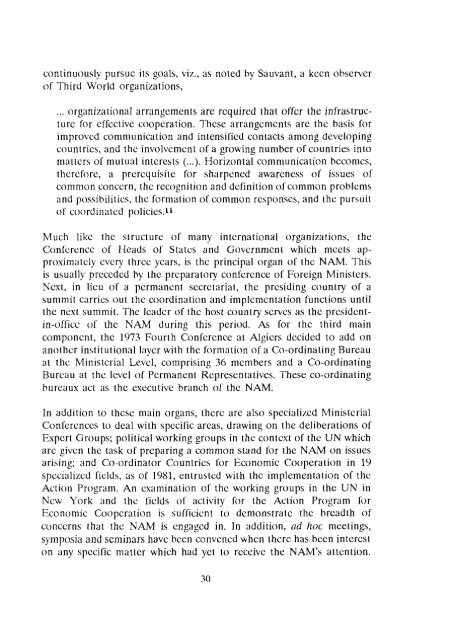ifda dossier 74 - Dag Hammarskjöld Foundation
ifda dossier 74 - Dag Hammarskjöld Foundation
ifda dossier 74 - Dag Hammarskjöld Foundation
Create successful ePaper yourself
Turn your PDF publications into a flip-book with our unique Google optimized e-Paper software.
continuously pursue its goals, vi~., as noted by Sauvant, a keen observer<br />
of Third World organizations,<br />
. organizational arrangements are required that offer the infrastruc-<br />
ture for effective cooperation. These arrangements are the basis for<br />
improved communication and intensified contacts among developing<br />
countries, and the involvement of a growing number of countries into<br />
matters of mutual interests (...). Horizontal communication becomes,<br />
therefore, a prerequisite for sharpened awareness of issues of<br />
common concern, the recognition and definition of common problems<br />
and possibilities, the formation of common responses, and the pursuit<br />
of coordinated policies.11<br />
Much like the structure of many international organizations, the<br />
Conference of Heads of States and Government which meets ap-<br />
proximately every three years, is the principal organ of the NAM. This<br />
is usually preceded by the preparatory conference of Foreign Ministers.<br />
Next, in lieu of a permanent secretariat, the presiding country of a<br />
summit carries out the coordination and implementation functions until<br />
the next summit. The leader of the host country serves as the president-<br />
in-office of the NAM during this period. As for the third main<br />
component, the 1973 Fourth Conference at Algiers decided to add on<br />
another institutional layer with the formation of a Co-ordinating Bureau<br />
at the Ministerial Level, comprising 36 members and a Co-ordinating<br />
Bureau at the level of Permanent Representatives. These co-ordinating<br />
bureaux act as the executive branch of the NAM.<br />
In addition to these main organs, there are also specialized Ministerial<br />
Conferences to deal with specific areas, drawing on the deliberations of<br />
Expert Groups; political working groups in the context of the UN which<br />
arc given the task of preparing a common stand for the NAM on issues<br />
arising; and Co-ordinator Countries for Economic Cooperation in 19<br />
specialized fields, as of 1981, entrusted with the implementation of the<br />
Action Program. An examination of the working groups in the UN in<br />
New York and the fields of activity for the Action Program for<br />
Economic Cooperation is sufficient to demonstrate the breadth of<br />
concerns that the NAM is engaged in. In addition, ad hoc meetings,<br />
symposia and seminars have been convened when there has been interest<br />
on any specific matter which had yet to receive the NAM's attention.
















